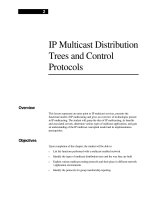Tài liệu Indoor wireless coverage stadium and arena coverage doc
Bạn đang xem bản rút gọn của tài liệu. Xem và tải ngay bản đầy đủ của tài liệu tại đây (279.16 KB, 2 trang )
CASE STUDY
InDoor WIrElESS CovErAgE
STADIUm AnD ArEnA CovErAgE
BACKGROUND
Large facilities such as stadiums and arenas require wireless coverage.
However, the sporadic and infrequent demands for coverage present
challenges for service providers. If sufficient capacity and coverage is not
available when needed, service providers risk lost revenue and subscriber
churn. However, if dedicated capacity is placed within such facilities, it
frequently goes unutilized when events are not taking place. The result
is ineffective use of capital expenditure, lost revenue, and decreased
profitability for the service provider.
THE PROBLEM
A wireless service provider wanted to provide improved coverage to a
popular stadium in the New York metropolitan area. Some service was
already being provided to the stadium through the outdoor macrocell
network. But once the stadium started to fill for events, subscribers
within the audience would experience dropped calls and lack of service.
Due to the inefficient coverage of the macrocell, capacity could not be
fully accessed because the signals would not penetrate the stadium.
Installing a base transceiver station dedicated to the stadium would
require a significant capital investment and result in inefficient use of
capacity because the stadium was only used periodically for events.
Web Site: www.adc.com
From North America, Call Toll Free: 1-800-366-3891 • Outside of North America: +1-952-938-8080
Fax: +1-952-917-3237 • For a listing of ADC’s global sales office locations, please refer to our Web site.
ADC Telecommunications, Inc., P.O. Box 1101, Minneapolis, Minnesota USA 55440-1101
Specifications published here are current as of the date of publication of this document. Because we are continuously
improving our products, ADC reserves the right to change specifications without prior notice. At any time, you may
verify product specifications by contacting our headquarters office in Minneapolis. ADC Telecommunications, Inc.
views its patent portfolio as an important corporate asset and vigorously enforces its patents. Products or features
contained herein may be covered by one or more U.S. or foreign patents. An Equal Opportunity Employer
103145AE 7/06 Revision © 2006 ADC Telecommunications, Inc. All Rights Reserved
CASE STUDY
THE ADC SOLUTION
ADC worked with the client to configure a
digital fiber optic microcell system that allowed
a significant number of the RF channels to be
redirected from the area outside of the stadium
to the inside. This would improve coverage and
increase capacity as people converged from the
parking lots to the indoor areas during events.
Two 50-watt remote units were placed inside the
stadium to provide coverage within the stadium
area, hallways, and boxes. These units were
optically fed from host units centralized at an
existing cell site about five miles away from the
stadium. The host unit digitizes the RF signals,
digitally transports them over fiber optic cable to
the remote unit where the RF signals are perfectly
reconstructed and distributed throughout the
stadium. Digital optical RF transport provides
superior signal quality with no added noise.
The versatility of digital RF transport also allows
placement of capacity and coverage wherever
needed and the flexibility to accommodate future
alternative technologies.
BENEfITS REALIzED By
THE CUSTOMER
Because ADC expanded upon the existing
network, costs were kept to a minimum. Use of
ADC's digital fiber optic microcell system allowed
the service provider to cost-effectively achieve
increased coverage through redistributing the
capacity when and where it is needed most.
With the use of a zone selector, capacity could
be redirected to the inside of the stadium as
demands within the facility increase. When the
stadium is not in use, capacity can be reallocated
back to the surrounding areas. Subscribers have
service when and where they need it both within
and outside the facility, experience fewer dropped
calls, and are less likely to churn. In addition, the
service provider may capture additional revenues
from mobile usage within the facility without
sacrificing revenues from the surrounding area.









